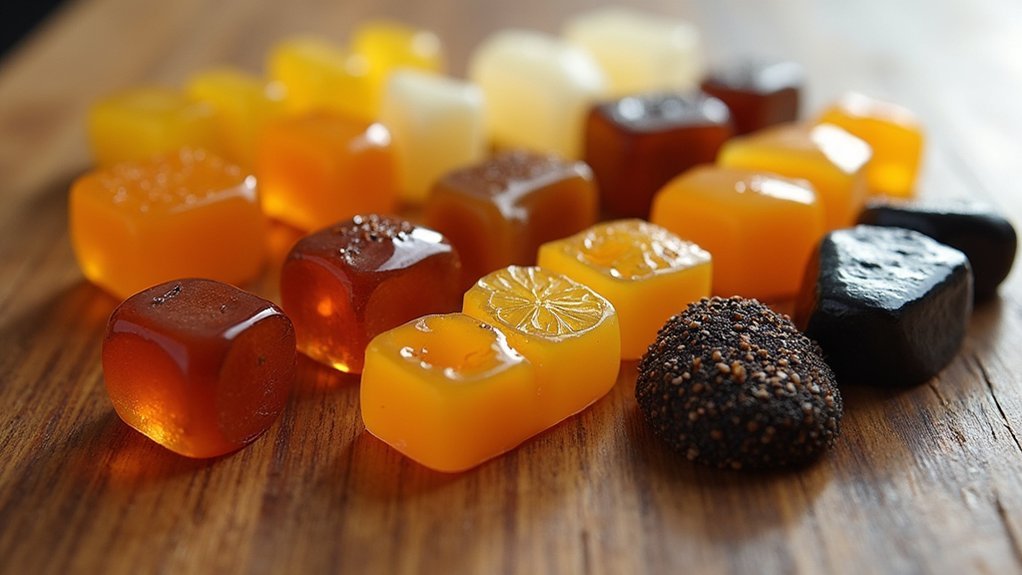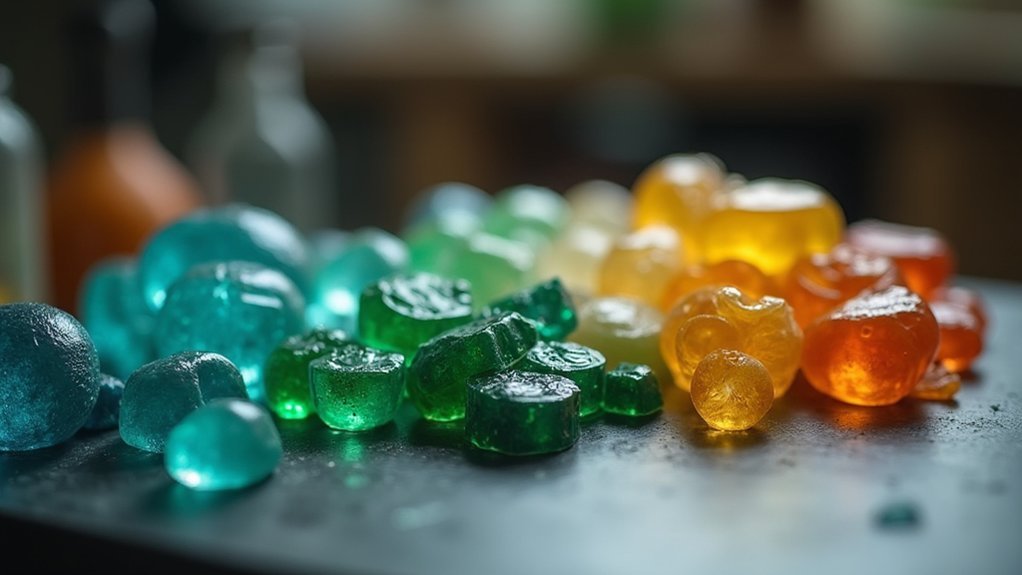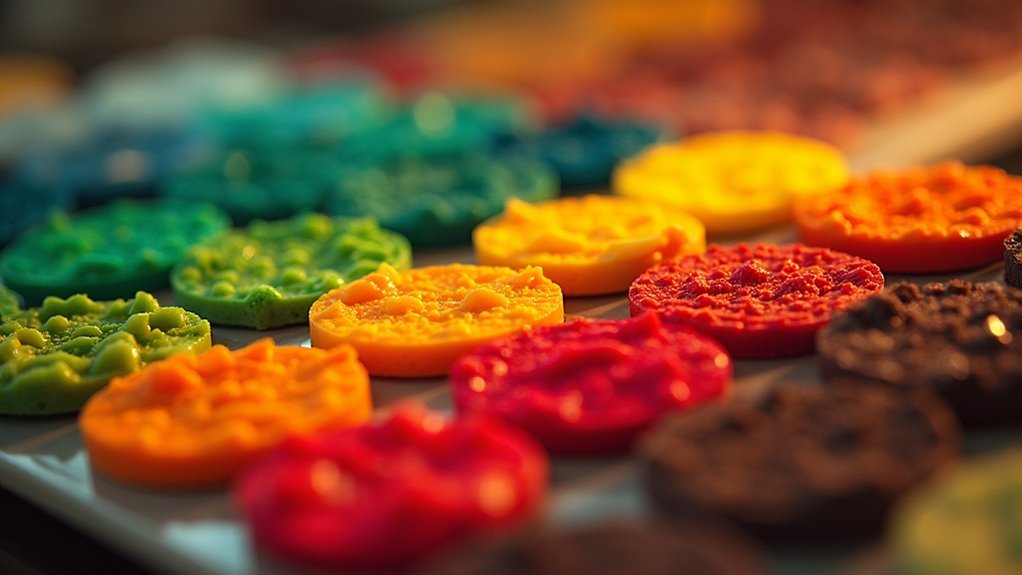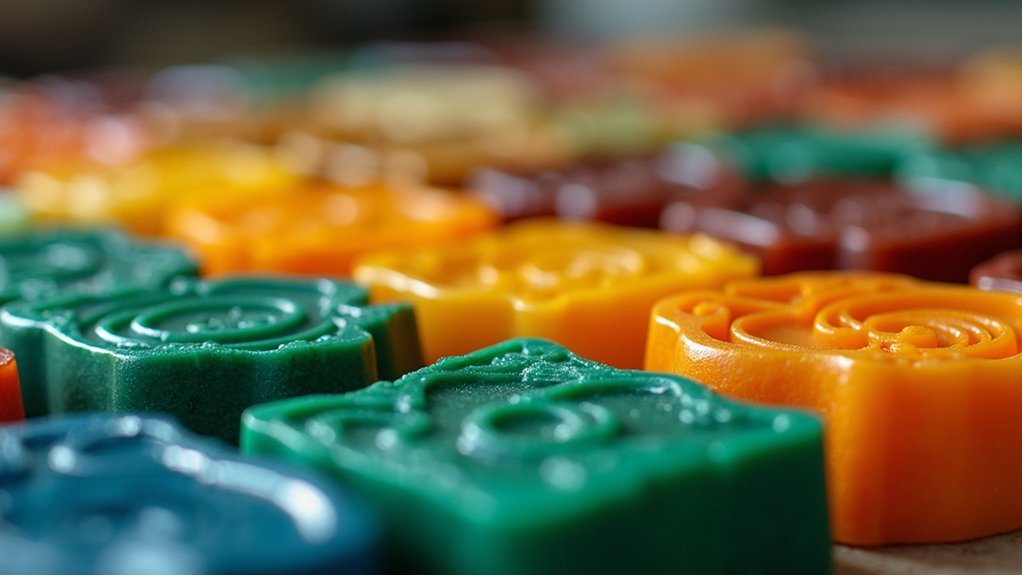You’ll achieve superior casting results by matching wax properties to your specific project needs. Natural waxes like beeswax burn cleanly, while microcrystalline varieties offer exceptional detail retention with melting points between 140°F-200°F. For intricate jewelry work, harder waxes like French Red provide superior detail but require careful handling due to brittleness. Water-soluble options work perfectly for hollow models at economical prices. Understanding these characteristics and employing strategic blending techniques will transform your casting success.
Understanding Natural Vs Synthetic Wax Properties

When choosing between natural and synthetic waxes for your casting projects, you’ll need to understand how their distinct properties affect your final results.
Natural waxes like beeswax and candelilla burn cleanly with minimal residue and less acrid smoke, making them ideal when clean burning is essential. They’re also eco-friendly and biodegradable.
Synthetic waxes, derived from petroleum refining, offer wider melting points and hardness levels, giving you more sculpting versatility. Microcrystalline wax, one type of wax in the synthetic category, provides exceptional elasticity with melting points between 140°F-200°F, perfect for detailed work.
Your choice depends on project requirements including desired detail, budget, and the specific properties each type of wax brings to your cast piece.
Microcrystalline Wax Varieties and Applications
You’ll find three distinct Victory wax varieties that each serve specific casting needs based on their unique properties.
Victory Brown offers exceptional softness and adhesion but tends to bleed, while Amber Victory provides balanced characteristics for general sculpting work.
White Victory stands out as the hardest option with the highest melting point, making it ideal for detailed work requiring dimensional stability.
Victory Brown Properties
Among the microcrystalline wax varieties available to sculptors, victory brown stands out for its distinctive soft, sticky texture that makes it particularly well-suited for building and constructing hollow models.
This wax’s properties include a melting range between 140°F to 200°F, making it versatile for detailed sculpting techniques. However, you’ll need to handle it carefully since it’s prone to bleeding and crumbling, which can compromise your work’s integrity.
The tacky nature works to your advantage when attaching additional layers without adhesives, streamlining your process. Unlike hard waxes, victory brown’s pliability enhances efficiency.
When purchasing, buy in bulk to guarantee consistency, as properties can vary between manufacturers and seasons, affecting your sculpting results.
Amber Victory Characteristics
Amber victory wax offers sculptors a harder alternative to victory brown, requiring heat application for effective attachment during your sculpting and casting workflow.
This microcrystalline wax maintains its structural integrity at higher temperatures, making detailed carving work more manageable. Its ideal melting point allows you to create intricate designs without compromising the wax’s durability.
You’ll appreciate amber victory’s resistance to bleeding and crumbling, ensuring your wax pieces remain intact throughout the process.
The material excels in applications demanding superior surface finish quality, as it polishes to a remarkable high gloss that enhances your final product’s aesthetic appeal.
Consider purchasing amber victory wax in bulk since availability and properties vary by manufacturer and season, guaranteeing consistent results across your projects.
White Victory Applications
While amber victory wax provides excellent durability, white victory wax stands as the hardest microcrystalline option available, delivering unmatched precision for your most demanding sculpting projects.
You’ll find this wax excels when you need to detail well intricate jewelry designs, as its high melting point of 140°F to 200°F gives you extended working time for complex modeling work.
White victory’s superior detail retention makes it your go-to choice for capturing fine textures and delicate features in your wax model.
You can combine it with other types of wax to boost your model’s overall strength and durability. Its petroleum solvent solubility guarantees you’ll achieve smooth, professional finishes on your final cast pieces every time.
Hard Carving Waxes for Detailed Work
When you’re selecting hard carving wax for detailed work, color choice isn’t just aesthetic—it directly impacts your ability to see fine details and imperfections during carving.
You’ll find that darker waxes like French red reveal surface details more clearly than lighter varieties, while brighter colors can help you spot tiny flaws that might otherwise go unnoticed.
The trade-off you’ll face is that harder waxes give you exceptional detail retention but become increasingly brittle, requiring more careful handling as you push toward finer work.
Color Selection Importance
Precision defines the difference between successful detailed wax carving and frustrating setbacks.
When selecting hard carving waxes, color isn’t just aesthetic—it directly impacts your work’s quality and efficiency. Green wax delivers exceptional precision for intricate details but demands patience due to its slower working properties.
Purple wax strikes an ideal balance, offering hardness for sharp edges while maintaining enough flexibility for complex designs. Blue wax provides versatility for general purposes, though it won’t match the detail retention of harder alternatives.
Your color selection determines how well you’ll execute fine details and maintain crisp edges throughout the carving process.
- Green wax excels in precision work but requires more time investment
- Purple wax offers excellent balance between hardness and workability for detailed projects
- Color choice directly affects melting properties and repair capabilities
Brittleness Vs Detail
Hard carving waxes present an inherent trade-off that every jewelry maker must navigate carefully. You’ll achieve exceptional detail with hard carving waxes like Ferris green and French red, but you’re also working with materials that can chip or break during carving. The brittleness that makes these waxes hold sharp edges becomes your biggest challenge.
| Wax Type | Detail Level | Brittleness | Flexibility | Best Use |
|---|---|---|---|---|
| Ferris Green | Excellent | High | Low | Fine filigree |
| French Red | Superior | Very High | Very Low | Intricate patterns |
| Mixed Hard | Good | Medium | Medium | General detailed work |
| Pure Hard | Outstanding | Highest | Lowest | Precision casting |
| Modified Hard | Very Good | Low | High | Complex shapes |
You can improve flexibility by mixing harder waxes with softer additives like beeswax.
Water-Soluble Options for Hollow Models

Although traditional casting waxes work well for solid models, water-soluble waxes offer a game-changing approach when you’re creating hollow pieces.
These polyethylene glycol-based waxes dissolve completely in water, making them perfect for jewelry making applications where you need lightweight, detailed cores. At around $11 per pound, they’re an economical choice that delivers excellent working properties similar to paraffin.
You can easily melt and reuse these waxes, creating a sustainable workflow for experimental hollow casting techniques. They’re particularly valuable for thin-walled models where detail retention is essential and material costs matter.
- Create intricate hollow models by forming water-soluble cores that dissolve away cleanly
- Reduce casting weight and material costs while maintaining structural integrity
- Experiment freely with complex geometries knowing you can remelt failed attempts
Selecting Wax Based on Project Requirements
Water-soluble waxes represent just one piece of the casting puzzle—your project’s specific demands should drive every wax selection decision.
When planning intricate jewelry pieces, you’ll want to make French red wax your wax of choice since it’s hard enough to hold fine details while maintaining structural integrity during investment.
For larger sculptural works, softer options like victory brown allow easier manipulation and construction flexibility.
Consider your finished piece’s complexity when evaluating melting points—microcrystalline waxes’ 140°F to 200°F range prevents excessive heat exposure during sculpting.
Microcrystalline wax’s moderate melting range protects delicate details from heat damage while allowing comfortable working temperatures for complex projects.
Don’t overlook blending strategies either. Mixing carnauba or stearin into base wax enhances hardness and polish while optimizing costs, giving you professional results without breaking your budget.
Color-Coded Wax Systems for Precision Casting

When precision becomes paramount in your casting projects, color-coded wax systems transform the guesswork into a streamlined selection process.
You’ll find that each color offers distinct properties tailored for specific applications. Blue wax excels for detailed embellishments, while green provides the durability needed when precision carving is essential.
If your wax is hard like green varieties, you’ll achieve superior detail retention when you make a mold.
Turquoise offers softer manipulation for general purpose work, making it ideal for beginners. You can even combine colors—mixing purple and green optimizes the balance between workability and structural integrity.
Understanding melting points and flexibility characteristics allows you to match the perfect wax to your project’s demands.
- Blue wax: Specialized for intricate detail work and fine embellishments
- Green wax: Harder composition for precision carving and complex designs
- Combined colors: Strategic mixing for optimized detail retention and carving ease
Frequently Asked Questions
What Wax Is Best for Casting?
You’ll find victory brown wax works best for casting since it’s affordable, retains excellent detail, and has tackiness that’s perfect for building hollow models while maintaining professional-quality results.
What Is the Difference Between Green and Blue Jewelers Wax?
Green jewelers wax is harder and ideal for detailed, precise carving work, while blue wax is softer and more flexible, making it easier to manipulate for rounded surfaces and decorative embellishments.
Can You Reuse Casting Wax?
You can reuse casting wax by collecting and remelting it properly. However, limit reuse cycles since repeated melting changes consistency and introduces impurities. Heat it to appropriate temperatures to maintain workability.
What Are the Mistakes in Casting Lost Wax?
You’ll face problems if you don’t secure wax models properly, skip adequate plaster coverage, rush burnout timing, overheat investment, or choose wrong wax types for your casting method.
In Summary
You’ll achieve better casting results when you match your wax selection to your project’s specific demands. Don’t overlook the importance of understanding each wax type’s properties—whether you’re working with intricate details requiring hard carving waxes or creating hollow forms with water-soluble options. Take advantage of color-coded systems to streamline your workflow and reduce errors. Your investment in quality casting wax directly impacts your final piece’s success and professional finish.





Leave a Reply